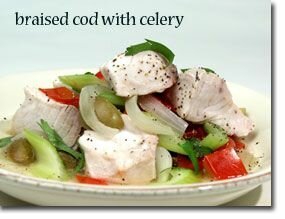If you don't know what to serve for dinner tonight ...
The combination of ingredients in this recipe offers a delicious flavor while providing you with an excellent source of health-promoting nutrients. And you can enjoy a complete meal in 30 minutes.

Ingredients:
- 1 medium onion, cut in half and sliced thick
- 6 cloves garlic, sliced
- 2 cups celery, cut diagonally about 1 inch long
- 1 15 oz can diced tomatoes, drained
- 3/4 cup green olives cut in fourths
- 1 TBS + 1/2 cup chicken or vegetable broth
- 1 TBS fresh lemon juice
- 1-1/2 lbs cod, cut into 2 inch pieces
- pinch red chili flakes
- salt and black pepper to taste
- 2 TBS chopped fresh cilantro
- Slice onion and garlic and let sit for 5 minutes to enhance its health-promoting benefits.
- Heat 1 TBS broth in a 10-12 inch skillet. Healthy Sauté chopped onion in broth over medium heat for 4-5 minutes, stirring frequently, until translucent.
- Add garlic and celery and sauté for another minute. Add drained diced tomatoes, green olives and remaining broth. Stir, cover, and simmer on medium-low for about 15 minutes, stirring occasionally, until celery is tender.
- Place cod, lemon, salt, pepper, and chili flakes on top of celery and continue to simmer covered for another 5 minutes, or until fish is cooked. Sprinkle with cilantro and serve.
- Brown Rice
In-Depth Nutritional Profile for Braised Cod with Celery
Healthy Food Tip
How safe is salmon with respect to mercury?
Based on an outstanding 2007 report by the U.S. Environmental Protection Agency (EPA), we've come up with four categories you can use to judge the mercury-safety of all types of seafood, including salmon. Here are your four safety categories that will show you how salmon fits into our overall evaluation of seafood and mercury risk:
Very low: This category includes our recommended best-choice seafood when it comes to avoidance of mercury. Wild-caught Alaskan and Pacific Coast salmon are found here, together with Pacific scallops, shrimp, oysters, clams, mussels, herring, and anchovies. We recommend this category for several meals per week. As you can see, two types of salmon (wild-caught Alaskan salmon and wild-caught Pacific salmon) are included in this very low risk category.
Low: This category still keeps your mercury intake at a relatively low level and seafood in this category could often be consumed one time per week. Included here are canned light tuna, Pacific cod, Pacific haddock, wild-caught Atlantic salmon, mahi mahi, canned light tuna, fresh/frozen Pacific tuna and Dungeness crab. As indicated in this list, wild-caught Atlantic salmon are included in this next-to-lowest risk category.
Medium: Most individuals could consume seafood in this category about once per month. A 6-10 ounce serving of any type of seafood in this "medium risk" category on a once-per-month basis would typically fit within a Healthiest Way of Eating. Some individuals in at-risk groups (like pregnant women) would need to keep consumption from this group at a lower level, in the range of only 4-8 ounces on a once-per-month basis. Fish included in this group are halibut, sea bass, grouper, albacore tuna, bluefish, canned albacore tuna, fresh/frozen Atlantic tuna, and Maine lobster.
High: We consider seafood in this group as those that should only be eaten on very rare occasions, and for individuals in higher-risk groups (like pregnant women or young children weighing less than 44 pounds), we treat them as seafood options that should be avoided altogether due to risk of mercury exposure. Fish in this group include swordfish, tilefish, marlin, shark, bluefin tuna, and king mackerel. (Please note that other types of mackerel-including Spanish mackerel, chub mackerel, blue mackerel, and many others-fall into lower-risk categories and can be eaten more frequently).
As you can see from our four level rating system, wild-caught salmon achieves our "very low" mercury rating provided that they are caught in waters outside of Alaska or along the Pacific coast of the United States (offshore from California, Oregon, and Washington). Wild-caught Atlantic salmon achieves the next best rating of "low." We only recommend farmed salmon if they have been organically farmed. Even though we have not yet seen data on the mercury content of organically farmed salmon, we are



No comments:
Post a Comment